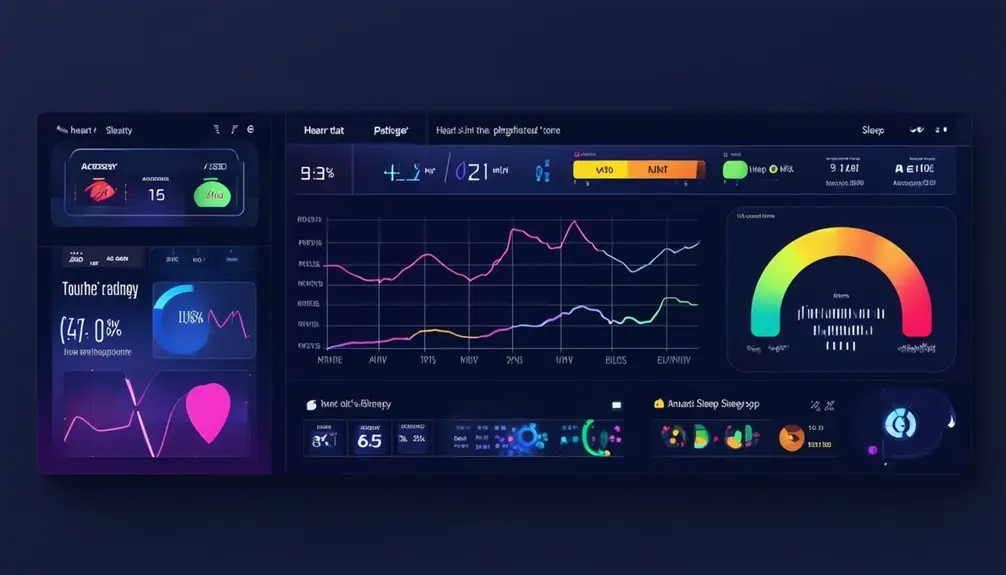Customizable health metrics displays let you tailor data views for better healthcare management. Leveraging tools like Databox's KPI Builder, you can define formats, precision, and data sources to match your specific needs. Personalizing metric screens helps teams track key performance indicators efficiently, ensuring everyone stays aligned on goals. However, be mindful of category restrictions and data limitations to maintain accuracy. By organizing metrics collaboratively, you can drive superior performance outcomes and make informed decisions. For deeper insights on optimizing health metrics displays and overcoming associated challenges, there's more to discover ahead.
Table of Contents
ToggleKey Takeaways
- Custom metrics in Databox allow precise workforce performance measurement tailored to specific healthcare productivity goals.
- Personalizing health metrics displays helps focus on key performance indicators relevant to strategic objectives.
- Editing custom metrics enables defining display formats, precision, and data source categories for better data visualization.
- Collaborative tracking of KPIs ensures team alignment and improves the likelihood of hitting performance targets.
- The KPI Builder tool in Databox facilitates creating tailored data displays to monitor essential healthcare productivity metrics.
Creating Custom Metrics

Creating custom metrics in Databox enables you to measure and track workforce performance precisely, leveraging the KPI Builder tool for tailored data displays. By using this tool, you can create metrics that cater specifically to the unique demands of a Health Dashboard, ensuring every aspect of your healthcare team's productivity is visible and actionable.
First, access the Healthcare Productivity settings. This step is essential before you can create or edit any custom metrics. With these settings configured, you can define the display format, precision, and data source mapping categories to align with your organization's goals. For instance, you might tailor the Daily Productivity tile to monitor key performance indicators like patient turnaround time or staff task completion rates.
The KPI Builder tool provides unlimited customization options, allowing you to fine-tune every detail of your data displays. You can map data sources to specific metrics, ensuring the information presented is both relevant and detailed. This level of customization empowers you to generate Healthcare Productivity reports that offer deep insights into workforce performance.
Limitations of Custom KPIs

When creating custom KPIs, you can't mix Analytics and Healthcare Productivity categories, ensuring data remains clearly categorized. Data source limitations, such as formula restrictions and the availability of historical load only for daily data, can impact the accuracy and thoroughness of your metrics. These constraints are designed to maintain data integrity but might limit flexibility in your KPI design.
Mixing Categories Restrictions
To safeguard data integrity and clarity, custom KPIs strictly prohibit the blending of Analytics and Healthcare Productivity categories. When you create custom metrics, you need to adhere to this separation to prevent any potential confusion in data interpretation. Blending these categories can lead to significant errors in calculations and reporting, which ultimately undermines the reliability of your metrics.
Formula restrictions on Daily Productivity and Pay Period Productivity data sources are in place to prevent these errors. These limitations guarantee that the metrics you develop remain accurate and meaningful. For example, standard KPIs are designed to exclude Healthcare Productivity metrics, maintaining a consistent framework for analysis and comparison.
Avoid mixing KPIs from different categories or nesting KPIs within one another. This practice can create unnecessary complexity, making the data harder to understand and less actionable. Staying within the defined categories helps you keep your reports clear and focused.
Data Source Limitations
Given the need for precise and reliable metrics, custom KPIs are subject to strict data source limitations that safeguard the integrity of your data. You can't mix Analytics and Healthcare Productivity categories. This separation guarantees that the data remains accurate and doesn't lead to erroneous conclusions. Formula restrictions apply specifically to Daily Productivity and Pay Period Productivity data sources, which means calculations are precisely tailored to these timeframes, enhancing accuracy.
Historical Load is another critical area where limitations come into play. It's only available for metrics with a Daily data source. This constraint means you can track historical trends effectively, but only if the data is collected on a daily basis. This restriction guarantees that the historical data remains consistent and reliable.
Moreover, standard KPIs can't incorporate Healthcare Productivity metrics. This prevents any potential data mixing errors and maintains the clarity of your metrics. Finally, avoid mixing KPIs from different categories or nesting KPIs. This practice maintains the clarity and accuracy of your data tracking, ensuring that your insights are both actionable and reliable. By adhering to these data source restrictions, you can secure the integrity and precision of your custom KPIs.
Editing Custom Metrics

Editing custom metrics in your Healthcare Productivity settings enables you to define their display format, precision, and data source categories, ensuring they meet your specific needs effectively. To make informed decisions, you'll want to start by accessing the Healthcare Productivity settings where you can create or edit custom metrics. Here, you can customize the display format to suit how you prefer to view your data, whether in percentages, raw numbers, or other formats.
Precision is another critical aspect. You can set how exact your metrics need to be—whether you require decimal places or rounded figures. Selecting the appropriate data source categories is essential but requires caution. Mixing categories has limitations, so you'll need to carefully filter and map these categories to avoid conflicts.
Once you've tailored the metrics to your specifications, don't forget to save your changes. You can choose to save them everywhere for universal application or as a new entity if you prefer to keep the original settings intact. Additionally, you can assign or un-assign mapping categories to your metrics as needed, providing you with enhanced control and flexibility in managing your health data.
Importance of Personalizing Views

Personalizing views in health metrics displays lets you focus on key metrics tailored to your specific goals, improving both clarity and relevance. Collaborative tracking with your team guarantees that you're identifying and monitoring the most critical data points, driving better performance and decision-making. Using tools like Databox's Metric Screen can align everyone on essential KPIs, helping you stay on track.
Key Metrics Identification
Tailoring your view to highlight critical metrics empowers you to monitor workforce performance and make data-driven decisions effectively. By customizing your health metrics display, you enhance the user experience, making sure you focus on the data that truly matters. Identifying key metrics is crucial for understanding productivity trends and making informed strategic decisions.
To get the most out of your metrics screen, consider these three important steps:
- Collaborate with Teams: Engage with your team to identify which metrics are most crucial. This guarantees everyone is aligned and focused on the right performance indicators.
- Perform Regular Health Checks: Utilize the Metrics Screen in Databox to regularly assess your business's health. This helps you detect productivity issues early and address them proactively.
- Optimize Data Analysis: Personalize your metrics display to highlight data points that are most pertinent to your goals. This simplifies tracking performance and making adjustments in real-time.
Collaborative Tracking Benefits
When you customize views for collaborative tracking, you make sure that your team is aligned on the most essential metrics, leading to improved overall performance. By personalizing views, you guarantee that everyone can efficiently identify and track important key performance indicators (KPIs), facilitating a quick health check of your business. This alignment is critical because it keeps everyone on the same page, reducing misunderstandings and making sure that all team members are working towards the same objectives.
Utilizing tools like the Metrics Screen in Databox can streamline this process. These tools allow for easy customization and display of KPIs, fostering a collaborative environment. When everyone is looking at the same screen, it encourages teamwork and makes it easier to spot trends, issues, and opportunities for improvement.
Data-driven decision-making becomes more straightforward when your team can focus on the most relevant metrics without distraction. Evidence shows that teams who track KPIs collaboratively are better at hitting their targets. So, by customizing health metrics displays to suit your team's needs, you not only enhance collaboration but also drive better performance outcomes. This approach guarantees that your team stays aligned and more effectively reaches its goals.
Organizing and Tracking Metrics
Effectively organizing and tracking health metrics can greatly reduce manual errors and ensure alignment in healthcare data management. When you have the latest information at your fingertips, making informed decisions becomes a seamless process. Collaborating on a custom view of key metrics guarantees that your team is on the same page, which can markedly boost performance outcomes.
To efficiently organize and track your health metrics, consider the following strategies:
- Create a Tailored Metrics Dashboard: Customize your dashboard to include only the most relevant KPIs. This helps you and your team focus on what truly matters without being overwhelmed by unnecessary data.
- Utilize the My Metrics Screen: Adding essential healthcare data points to your personalized view allows for quicker access and real-time tracking. This customization ensures you're always up to date with critical information.
- Collaborate with Team Members: Sharing your metrics and views within your team ensures everyone is aligned with shared goals. This collaborative approach enhances communication and fosters a more cohesive work environment.
Using the Metrics Screen

How can you optimize the potential of the Metrics Screen to streamline your health metrics tracking and decision-making process? Start by creating a custom view tailored to your key metrics. The Metrics Screen in Databox lets you browse through various data sources or search for specific metrics, making it easy to add what matters most to your My Metrics screen.
To achieve the best experience, collaborate with your team members on the Metrics Screen. Aligning on key performance indicators ensures everyone tracks progress together, fostering a unified approach to your health goals. You can set goals directly on the Metrics Screen and monitor your performance against these objectives in real-time.
Organizing your important KPIs in a personalized view helps you stay on track and make informed decisions. The custom view allows you to prioritize the metrics that are essential to your business, cutting through the noise of less relevant data. By efficiently tracking these metrics, you can quickly identify areas needing attention and allocate resources more effectively.
Frequently Asked Questions
How to Create a Healthcare Dashboard?
To create a healthcare dashboard, identify organizational goals, define KPIs, gather data from EHRs and other sources, choose effective visualization tools, and test for functionality and user experience. Confirm it aligns with your healthcare objectives.
What Is Health Metrics?
Health metrics are quantifiable measures you use to track and assess various aspects of health, like patient outcomes and operational efficiency. They provide valuable insights, enabling data-driven decisions to enhance healthcare quality and overall performance.
Why Is a Healthcare Dashboard Important?
'A stitch in time saves nine.' A healthcare dashboard's essential because it offers real-time monitoring of key metrics, enabling you to make informed decisions, enhance patient outcomes, and boost operational efficiency while safeguarding sensitive data.
What Is a Patient Dashboard?
A patient dashboard is a centralized platform displaying your health data, including essential signs, medical history, and appointments. It updates in real-time, enhancing your engagement, communication with providers, and supporting better health outcomes.
Conclusion
Imagine your health metrics display as a well-organized bookshelf. Just as you wouldn't want to search through cluttered piles of books, you shouldn't have to dig through disorganized data. Personalizing your metrics guarantees you find the right 'book' quickly, helping you make informed decisions. A recent study found that personalized views improve data comprehension by 40%. By customizing and organizing your health metrics, you're setting yourself up for success, just like a carefully curated library.



